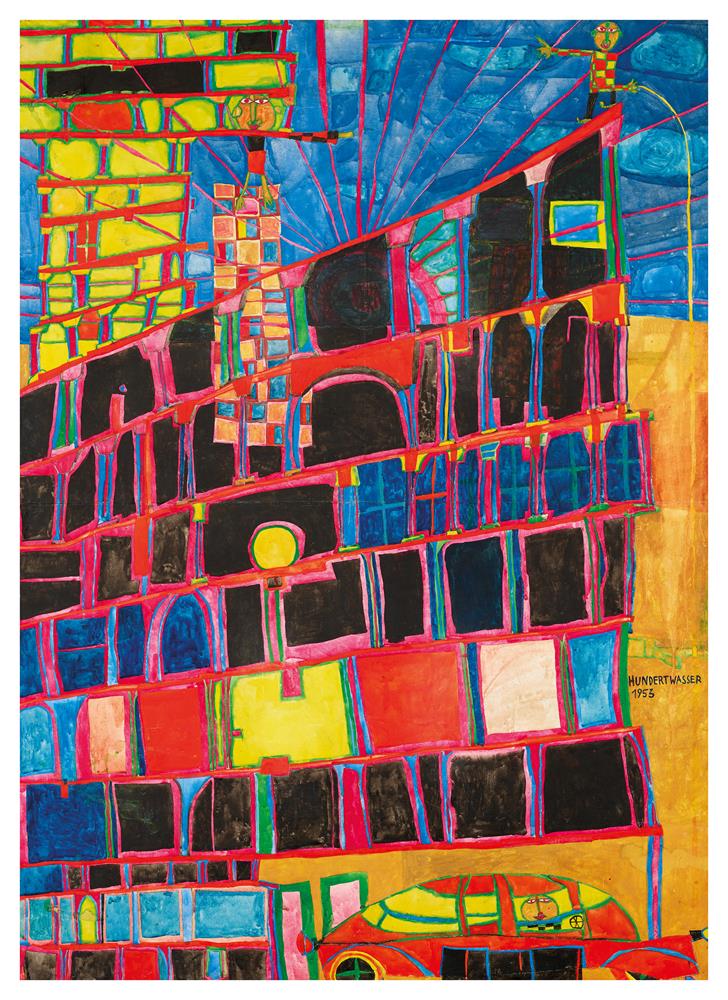
Vienna 1928 - 2000 Aboard the Queen Elizabeth II
"Arcade House with Yellow Tower"
Watercolour on paper, primed with chalk, zinc white and fish glue, mounted on canvas
123 x 89.5 cm
Signed and dated right: HUNDERTWASSER / 1953
Label on the reverse: KESTNER-GESELLSCHAFT / HANNOVER /
196 4 / Katalog-Nr. 165
Further label: MODERNA MUSEET STOCKHOLM SWEDEN
Further label: Museum des / 20. Jahrhunderts / Wien III /
Schweizergarten ... Österreich
Inscribed on the frame: COLLECTION: GIOTTA-RYU TAJIRI BAARLO
as well as numbered 165
Fürst WV no. 165
Provenienz:
Private collection Shinkichi Tajiri, Baarlo, Neatherlands
Ausstellungen:
Hanover, Kestner-Gesellschaft
Berne, Kunsthalle
Hagen, Karl-Ernst-Osthaus-Museum
Amsterdam, Stedelijk Museum
Stockholm, Moderna Museet
Vienna, Museum des 20. Jahrhunderts, ‘Hundertwasser’, 1964/1965
Rotterdam, Kunsthal, ‘Hunderwasser. Fantastische architectuur’, 2004
Amsterdam, Cobra Museum voor Moderne Kunst, ‘Hundertwasser:
De rechte lijn is Goodeloos’, 2014
Literatur:
Exhibition catalogue ‘Hundertwasser. Vollständiger Œuvre-Katalog mit 100 farbigen Reproduktionen’, ed. by Kestner-Gesellschaft, Hanover 1964, p. 120, no. 165
Exhibition catalogue ‘Hundertwasser’, Moderna Museet, Stockholm 1964/65, p. 3, no. 20 (165)
Werner Hofmann, Hundertwasser, Salzburg 1965, p. 27, ill. no. 9
Exhibition catalogue ‘Hundertwasser’, Museum des 20. Jahrhunderts Vienna III. Schweizergarten, Vienna 1965, p. 62, no. 28
Wieland Schmied, Hundertwasser, Österreicher des 20. Jahrhunderts, ed. by Werner Hofmann, Salzburg 1974, ill. p. 164f., no. 31 and p. 312, no. 31
Für ein natur- und menschengerechteres Bauen, Hundertwasser Architektur, ed. by Angelika Taschen, Köln 1996, ill. p. 21, no. 165
Wieland Schmied, Hundertwasser 1928–2000 Catalogue Raisonné. Vol. I, Vienna/Cologne 2000, ill. p. 43
Andrea Christa Fürst, Hundertwasser 1928–2000. Werkverzeichnis · Catalogue Raisonné. Vol. II, Cologne et al. 2002, p. 245, WV no. 165, ill. p. 246 and ill. p. 934, TAP 39, WV no. 165A (tapestry)
Friedensreich Hundertwasser, who is one of the most important Austrian artists even internationally, started his career early on in life. His position in the art scene is extraordinary, even for the avant-garde movement of the time. During the first years of the 1950s, the artist lived in Paris, where he started exhibiting, as well as in Vienna, Milan and Rome. He was friends with the likes of Yves Klein and Pierre Restany, and the tachism of the time inspired him, which led to his unmistakable art style. In the 50s he became a leading figure in the ornamental abstraction art scene. Besides the composition of his works, for Hundertwasser the philosophical aspects were important too, as nature was central to him. He vehemently advocated the protection of nature and ecological balance.
In his individual iconography, the spiral became an important symbol for life and death. He also chose not to draw straight lines, which he defended by saying that seeing them makes us sick, as they never naturally occur. Even his 90 degree angles are bent individually charged with Hundertwassers personal style, freed from all rigor. Our exceptional painting “Arcade house and yellow tower” from 1953 is an especially great example for that. Hundertwasser himself called it a painted premonition considering the Hundertwasser house that was built 40 years later. One of a kind, beautiful and decorative, the brightly colored building stands tall.
The slant of the building becomes more and more dramatic towards the top it. This lively linearity of the arcade structure finds an answer in the sky, which carries the rays of sunshine. There is a bright yellow tower in the upper left corner, which rises above the rest of the building. A figure is standing on the chimney, looking animated and another one stands at the highest point of the house, urinating off it in a high arch. Ironically enough, even this was foreshadowing, as the building site of the Hundertwasser house smelled like urine. After investigating, the artist found out, that the building workers would urinate exactly where they stood, as climbing down to use a restroom would have taken too long. Friedensreich Hundertwasser traded said painting with one of Shinkchi Tajiri’s iron sculptures, because he admired his works greatly and as both of them had ateliers in Paris.
Catalouge Raisonné. Bd II, Köln u. a. 2002, p. 246
